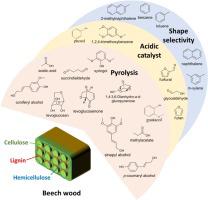当前位置:
X-MOL 学术
›
J. Anal. Appl. Pyrol.
›
论文详情
Our official English website, www.x-mol.net, welcomes your feedback! (Note: you will need to create a separate account there.)
The role of catalyst acidity and shape selectivity on products from the catalytic fast pyrolysis of beech wood
Journal of Analytical and Applied Pyrolysis ( IF 6 ) Pub Date : 2019-10-01 , DOI: 10.1016/j.jaap.2019.104710 Joseph Socci , Alireza Saraeian , Stylianos D. Stefanidis , Scott W. Banks , Brent H. Shanks , Tony Bridgwater
Journal of Analytical and Applied Pyrolysis ( IF 6 ) Pub Date : 2019-10-01 , DOI: 10.1016/j.jaap.2019.104710 Joseph Socci , Alireza Saraeian , Stylianos D. Stefanidis , Scott W. Banks , Brent H. Shanks , Tony Bridgwater

|
Abstract The catalytic fast pyrolysis (CFP) of biomass represents an efficient integrated process to produce deoxygenated stable liquid fuels and valuable chemical products from lignocellulosic biomass. The zeolite ZSM-5 is a widely studied catalyst for the CFP process. However, its microporous structure may limit the diffusion of high molecular weight pyrolysis intermediates to its active sites. Mesoporous aluminosilicates such as Al-SBA-15 are promising materials with larger pore sizes that can overcome these diffusional limitations. Previous comparisons between mesoporous aluminosilicates and ZSM-5 for the CFP process have neglected the disproportionately high acidity of ZSM-5. In this study, an Al-SBA-15 catalyst has been synthesised with high acidity, comparable to that of a ZSM-5 catalyst with a Si:Al ratio of 15:1. The synthesised Al-SBA-15 catalyst was characterised by N2 physisorption, XRD and propylamine-TPD, and was compared to a ZSM-5 catalyst and a typical industrial equilibrium fluid catalytic cracking catalyst (e-FCC). All three catalysts were used at three different catalyst to biomass (C/B) ratios, to investigate the effect of varying concentrations of acid sites on the product distribution from the catalytic fast pyrolysis of beech wood. Interestingly, despite their dissimilar structural architectures, all three solid acid catalysts displayed similar reaction pathways towards the cracking of high molecular weight products such as levoglucosan and formation of intermediates including phenolics and furans. However, the selectivity towards the final catalytic products was dictated mainly by the structure of the catalysts. Despite their very similar surface area and acidity, the ZSM-5 exhibited high selectivity for the formation of desirable aromatic hydrocarbon products due to its shape-selective micropore structure, while Al-SBA-15 instead shifted the selectivity towards the formation of undesirable coke. The results highlighted the importance of catalyst shape-selectivity in the catalytic fast pyrolysis of biomass for the conversion of pyrolysis vapours into desirable products and the suppression of undesirable solid byproduct formation.
中文翻译:

催化剂酸度和形状选择性对榉木催化快速热解产物的影响
摘要 生物质的催化快速热解 (CFP) 代表了一种有效的综合过程,可以从木质纤维素生物质中生产脱氧稳定的液体燃料和有价值的化学产品。沸石 ZSM-5 是一种广泛研究的用于 CFP 工艺的催化剂。然而,其微孔结构可能会限制高分子量热解中间体向其活性位点的扩散。介孔铝硅酸盐如 Al-SBA-15 是具有较大孔径的有前途的材料,可以克服这些扩散限制。先前在 CFP 工艺中中孔铝硅酸盐和 ZSM-5 之间的比较忽略了 ZSM-5 不成比例的高酸度。在这项研究中,合成了一种具有高酸度的 Al-SBA-15 催化剂,与 Si:Al 比为 15:1 的 ZSM-5 催化剂相当。合成的 Al-SBA-15 催化剂通过 N2 物理吸附、XRD 和丙胺-TPD 进行表征,并与 ZSM-5 催化剂和典型的工业平衡流化催化裂化催化剂 (e-FCC) 进行了比较。所有三种催化剂均以三种不同的催化剂与生物质 (C/B) 比率使用,以研究不同浓度的酸位对山毛榉木材催化快速热解产物分布的影响。有趣的是,尽管它们的结构不同,但所有三种固体酸催化剂在裂解高分子量产物(如左旋葡聚糖)和形成中间体(包括酚类和呋喃)方面表现出相似的反应途径。然而,对最终催化产物的选择性主要取决于催化剂的结构。尽管它们的表面积和酸度非常相似,但由于其形状选择性微孔结构,ZSM-5 对形成所需的芳烃产品表现出很高的选择性,而 Al-SBA-15 反而将选择性转移到形成不需要的焦炭。结果强调了催化剂形状选择性在生物质催化快速热解中的重要性,用于将热解蒸气转化为所需的产物和抑制不想要的固体副产物形成。
更新日期:2019-10-01
中文翻译:

催化剂酸度和形状选择性对榉木催化快速热解产物的影响
摘要 生物质的催化快速热解 (CFP) 代表了一种有效的综合过程,可以从木质纤维素生物质中生产脱氧稳定的液体燃料和有价值的化学产品。沸石 ZSM-5 是一种广泛研究的用于 CFP 工艺的催化剂。然而,其微孔结构可能会限制高分子量热解中间体向其活性位点的扩散。介孔铝硅酸盐如 Al-SBA-15 是具有较大孔径的有前途的材料,可以克服这些扩散限制。先前在 CFP 工艺中中孔铝硅酸盐和 ZSM-5 之间的比较忽略了 ZSM-5 不成比例的高酸度。在这项研究中,合成了一种具有高酸度的 Al-SBA-15 催化剂,与 Si:Al 比为 15:1 的 ZSM-5 催化剂相当。合成的 Al-SBA-15 催化剂通过 N2 物理吸附、XRD 和丙胺-TPD 进行表征,并与 ZSM-5 催化剂和典型的工业平衡流化催化裂化催化剂 (e-FCC) 进行了比较。所有三种催化剂均以三种不同的催化剂与生物质 (C/B) 比率使用,以研究不同浓度的酸位对山毛榉木材催化快速热解产物分布的影响。有趣的是,尽管它们的结构不同,但所有三种固体酸催化剂在裂解高分子量产物(如左旋葡聚糖)和形成中间体(包括酚类和呋喃)方面表现出相似的反应途径。然而,对最终催化产物的选择性主要取决于催化剂的结构。尽管它们的表面积和酸度非常相似,但由于其形状选择性微孔结构,ZSM-5 对形成所需的芳烃产品表现出很高的选择性,而 Al-SBA-15 反而将选择性转移到形成不需要的焦炭。结果强调了催化剂形状选择性在生物质催化快速热解中的重要性,用于将热解蒸气转化为所需的产物和抑制不想要的固体副产物形成。


























 京公网安备 11010802027423号
京公网安备 11010802027423号